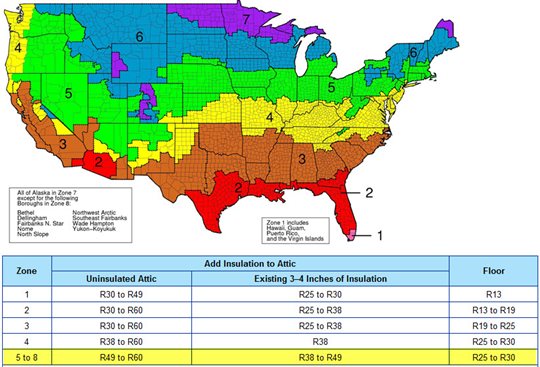As a homeowner, you might question if your attic insulation is adequate. If your existing home insulation is from the 1960s or earlier, it will likely need more insulation.
The fastest way to tell if you need more insulation is if your existing material is even with or lower than your wood floor beams. If it is, you might have air leaks and need to reinsulate. Other signs include if your second floor stays warm, your air conditioner runs more frequently or your roof has icicles in the winter.
Why Attic Insulation R-Value Matters
R-value is based on density, thickness and material. Hence, to increase your attic insulation’s R-value, add more insulation. The Department of Energy states that homeowners can lower heating and cooling costs by up to 20% with attic, crawl space, floor and basement insulation.
Understanding the Insulation R-Value Guide
Take a look at the Insulation R-Value Guide. Climate zones are numbered from one to eight and include ratings for uninsulated attics, existing three to four inches of insulation, floors and walls.
Areas with warmer climates will have lower R-value numbers, while regions with colder climates will have R-values in the R-49 to R-60 range.
Once you know how much additional attic insulation you need, consider upgrades to block heat and improve your home’s comfort level. If you’re uncertain about calculating your R-value, schedule a free in-home insulation consultation and a BPI-certified technician will gladly assist.
We can replace deteriorated insulation sections with the highest-quality reinsulating materials.

Source: energystar.gov
Understanding R-Value
R-value is your insulation’s efficiency rating, which determines its resistance to heat. The higher the number, the better its ability to keep your home comfortable and sustainable. However, you’ll need different insulation R-values throughout your home. Here’s an example.
The R-value per inch for wood is 1. If a wood beam is 3 inches thick, its R-value is 3. Adding fiberglass insulation to an attic with an R-value of 2.2 per inch gives us 12 inches and an R-value of 26.4.
The good news about insulation is that future trends show smart insulation advancements, with sectors that can detect temperature changes. Aerogels, or “frozen smoke,” are another option. The lightweight material prevents heat transfer and is ideal for construction projects.
Calculating R-Value for Your Attic
Finding the right insulation R-value is important when air-sealing your attic and keeping moisture out. Idaho homes have a climate zone of 5 for their R-value, or R-38 to R-60.
To calculate the R-value for your attic:
- Measure the depth and type of insulation in the attic.
- Identify the R-value of the existing insulation material.
- Determine the desired R-value based on climate and energy efficiency goals.
- Calculate the additional insulation needed to reach the desired R-value.
Tips for Increasing R-Value
Attics need a thermal barrier to keep heat out as heat and humidity rise. You also want to preserve your roof covering and avoid leaks. Heating and cooling account for almost 50% of annual utility costs.
Top attic insulation products include fiberglass roll or batt, cellulose loose-fill, spray foam, mineral wool and radiant barrier.
While insulation methods can vary by home price and preference, look for new advances in nanotechnology that add increased durability and thermal resistance. Sustainable and biodegradable insulation is also trending, as natural fibers can reduce environmental impacts.
Why Choose Big City Insulation of Idaho?
Outdated attic insulation can cause drafts and strain your HVAC system, leading to premature mechanical breakdowns. Calculating your existing attic insulation’s R-value or thermal resistance can help ensure you add the appropriate insulating materials to lower utility costs, and we can assist you.
Part of the IBP Family of Companies, Big City Insulation of Idaho has excellent feedback and can offer the resources and expertise few Boise-area companies can match.
Schedule insulation installation in your Idaho home. Contact Big City Insulation of Idaho today.










